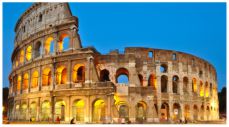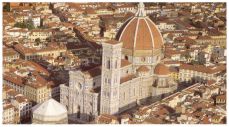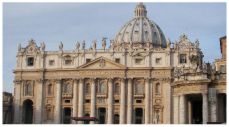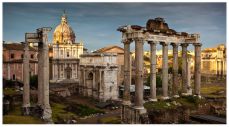Italy has Europe's richest, craziest culture. After all, this nation is the cradle of European civilization — established by the Roman Empire and carried on by the Roman Catholic Church. As you explore Italy, you'll stand face-to-face with some of the world's most iconic images from this 2,000-year history: the Colosseum of Ancient Rome, the medieval Leaning Tower of Pisa, Michelangelo'sDavid and Botticelli's Venus, the playful Baroque exuberance of the Trevi Fountain…and the elegant decay that surrounds the canals of Venice. Beyond these famous sights, though, Italy offers Europe's richest culture. Traditions still live within a country that is vibrant and fully modern. Go with an eye open to both the Italy of the past and of the present.
At a Glance
PLAN YOUR TOUR
4 Days:Florence, Venice 6 Days, add:Rome 8 Days, add: Cinque Terre 10 Days, add:Civita and Siena 14 Days, add:Sorrento, Naples, Pompeii, Amalfi Coast, Paestum 18 Days, add:Milan, Lake Como, Varenna, Assisi 21 Days, add:Dolomites, Verona, Padua
Things To Do:
*Venice Romantic island city, powerful in medieval times; famous for St. Mark's Basilica, the Grand Canal, and singing gondoliers.
* Cinque Terre Five idyllic Riviera hamlets along a rugged coastline (and part of a national park), connected by scenic hiking trails and dotted with beaches.
* Florence The cradle of the Renaissance, with the world-class Uffizi Gallery, Brunelleschi's dome-topped Duomo, Michelangelo's David, and Italy's best gelato.
* Siena Florence's smaller and (some say) more appealing rival, with its grand Il Campo square and striking striped cathedral.
* Rome Italy's capital, the Eternal City, studded with Roman remnants (Forum, Colosseum, Pantheon), romantic floodlit-fountain squares, and the Vatican — home to one of Italy's top museums and the Sistine Chapel.
*Milan Powerhouse city of commerce and fashion, with the prestigious La Scala opera house, Leonardo's The Last Supper, and three airports.
*Heart of Tuscany Picturesque, wine-soaked villages of Italy's heartland, including mellow Montepulciano, Renaissance Pienza, and Brunello-fueled Montalcino.
*Assisi St. Francis' hometown, perched on a hillside, with a divinely Giotto-decorated basilica.
*Orvieto and Civita More hill-town adventures, featuring Orvieto's classic views and ornate cathedral plus the adorable pocket-sized village of Civita di Bagnoregio.
* Naples Gritty, in-love-with-life port city featuring vibrant street life and a top archaeological museum.
*Near Venice Several interesting towns: Padua (with Giotto's gloriously frescoed Scrovegni Chapel), Verona (Roman amphitheater plus Romeo and Juliet sights), and Ravenna (top Byzantine mosaics).
*The Dolomites Italy's rugged rooftop with a Germanic flair, featuring Bolzano (home of Ötzi the Iceman), Castelrotto (charming village), and Alpe di Siusi (alpine meadows laced with lifts and hiking trails).
* The Lakes Two relaxing lakes, each with low-key resort towns and a mountainous backdrop: Lake Como, with quaint Varenna and upscale Bellagio; and Lake Maggiore, with straightforward Stresa, manicured islands, and elegant villas.
*Pisa and Lucca Two classic towns: Pisa, with its famous Leaning Tower and surrounding Field of Miracles, and Lucca, with a charming walled old center.
*Volterra and San Gimignano Two hill towns in north Tuscany: vibrant, refreshing Volterra and multi-towered, touristy San Gimignano.
*Pompeii and Nearby Famous ruins of the ancient towns of Pompeii and Herculaneum, stopped in their tracks by the eruption of Mount Vesuvius.
*Sorrento and Capri The seaside resort port of Sorrento, and a short cruise away, the jet-set island getaway of Capri, with its Blue Grotto.
*Amalfi Coast and Paestum String of seafront villages — including hilly Positano and workaday Amalfi — tied together by a scenic mountainous coastal road, plus nearby Paestum, with its well-preserved ancient Greek temples.
When to Go
Italy's best travel months (also its busiest and most expensive) are May, June, September, and October. These months combine the convenience of peak season with pleasant weather. The most grueling thing about travel in Italy — particularly in the south — is the summer heat in July and August, when temperatures hit the high 80s and 90s. Most mid-range hotels come with air-conditioning — important in the summer — but it's usually available only from June through September. Peak season (roughly May–Oct in the north and May–June and Sept–Oct in the south) offers the longest hours and the most exciting slate of activities — but terrible crowds. During peak times, many resort-area hotels maximize business by requiring that guests take half-pension, which means buying a meal per day (usually dinner) in their restaurants. August, the month when many Italians take their summer vacations, isn't as bad as many make it out to be, but big cities tend to be quiet (with discounted hotel prices), and beach and mountain resorts are jammed (with higher hotel prices). Note that Italians generally wear shorts only at beach resort towns. If you want to blend in, wear lightweight long (or Capri) pants in Italy, even in summer, except at the beach. Between November and April, you can usually expect pleasant weather, and you'll miss most of the sweat and stress of the tourist season. Off-season, expect shorter hours, more lunchtime breaks, and fewer activities. However, spring and fall can be cool, and many hotels — thanks to a national interest in conserving energy — aren't allowed to turn on their heat until winter. In the winter, it often drops to the 40s in Milan and the 50s in Rome.






